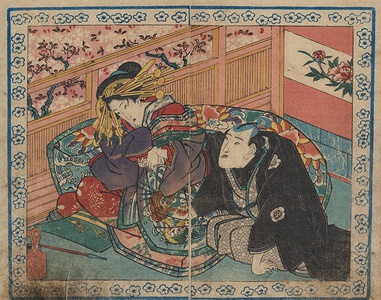| Method | Woodblock (nishiki-e) |
| Artist | Utagawa Sadatora (active circa 1818-1844) |
| Published | 1831 |
| Dimensions | Double chūhon [each sheet ~155 x 222 mm] |
| Notes |
Series: Kaichu soshi: The Vagina Taoist Author: Bunya Nakiyasu A print from Volume I of Utagawa Sadatora's Kaichu soshi: The Vagina Taoist a parody of the collection of essays Inaka soji: The Country Taosit by samurai Issai Chozan published in 1727. Here an orian entertains a client on the balcony of a brothel with flowering cherry trees in background, the man's hand reaches into her kimono, she wears, numerous decorative hair pins, and an elaborate kimono with waves and peonies all surrounded by a decorative printed boarder of cherry blossoms printed in blue all symbols of female sexuality. Shunga is the term used for the body of erotic imagery produced in Japan from 1600 to 1900. The term shunga means spring pictures, a euphemism for sex, and is one of several names for erotic material produced in Japan. Shunga took different formats: painted hand scrolls, painted books, printed books and albums, and sets of prints which were sometimes sold in wrappers. As prints they are one of the genres of ukiyo-e, or Floating World prints, which also include fukeiga (landscape prints), and bijin-ga (prints of beautiful women). Most of the major ukiyo-e artists produced shunga material at some point during their careers, including Utamaro (who produced more erotic books than non-erotic books), Hokusai, and Hiroshige. Produced at the same time as the introduction of full colour woodblock printing, shunga prints and books were made using the most lavish and complicated printing techniques, including gauffrage, metallic inks, mica, complicated printed patterns, and multicolour printing using a high number of different colours. Although prolific in its number and variety, shunga should be seen as more representative of the ideals of the ukiyo, with its emphasis on mutual pleasure, rather than as an accurate representation of Japanese attitudes and practices of sexuality. Shunga present an invitation to pleasure through the bliss of lovemaking and though largely heteronormative, they portray the full gamut of couplings, married or otherwise, often surrounded by lavish settings and objects of pleasure. Utagawa Sadatora (active circa 1818-1844) was an Edo ukiyo-e artist and pupil of Kunisada. Ex. Col.: Peter Darach Condition: Light overall soiling and some rubbing and soiling on lower right and left corners. Sheets have been trimmed, joined and laid to a backing sheet. |
| Framing | unmounted |
| Price | £150.00 |
| Stock ID | 53197 |

